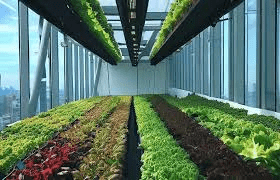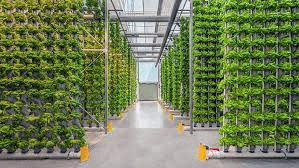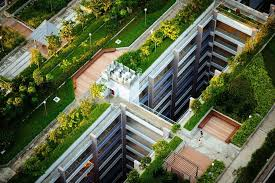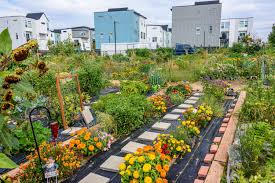Urban agriculture involves growing food in city environments. It can take place in small spaces such as balconies, rooftops, or community gardens. This practice helps make cities more sustainable by improving access to fresh food, reducing the carbon footprint associated with transporting food, and enhancing community engagement.
Benefits of Urban Agriculture
1. Access to Fresh Food: Urban agriculture provides fresh produce to city residents, often in areas where access to healthy food is limited.
2. Environmental Sustainability: Growing food locally reduces the need for transportation, which cuts down on greenhouse gas emissions.
3. Community Engagement: Community gardens and other urban agriculture projects foster social interaction and cooperation among residents.
4. Educational Opportunities: Urban agriculture can be a valuable educational tool, teaching people about food production, nutrition, and environmental stewardship.
5. Economic Savings: Growing your own food can save money on grocery bills and create potential income through selling surplus produce.
Types of Urban Agriculture
Urban agriculture comes in various forms. Here are some common types:
1. Community Gardens: Shared plots of land where individuals or groups grow fruits, vegetables, and herbs. These gardens are often located in unused city spaces and are managed by local community organizations.
2. Rooftop Gardens: Gardens established on the roofs of buildings. They utilize unused roof space to grow plants and can help insulate buildings, reducing energy costs.
3. Vertical Farming: A method of growing crops in stacked layers or vertically inclined surfaces. It maximizes space usage and can be implemented in various settings, from warehouses to skyscrapers.
4. Indoor Farming: Growing plants inside buildings using controlled environments. This includes using hydroponics, aeroponics, and other methods to grow crops year-round regardless of outdoor conditions.
Community Gardens

1. Establishing a Community Garden: Begin by finding a suitable plot of land, such as vacant lots or unused public spaces. Form a community group to manage the garden and obtain necessary permissions from local authorities.
2. Planning and Design: Design the garden layout, including plots for different crops, pathways, and communal areas. Consider factors like sunlight, water access, and soil quality.
3. Maintenance: Regular maintenance involves watering, weeding, and harvesting. Encourage community members to participate and share responsibilities.
4. Benefits: Community gardens foster social interaction, provide fresh produce, and can improve the aesthetic of urban areas.
Rooftop Gardens
1. Choosing a Roof: Ensure the roof is structurally sound and able to support the weight of the garden. Obtain permission from building owners or authorities.
2. Designing the Garden: Use lightweight soil and containers to reduce the load on the roof. Plan for irrigation and access to sunlight.
3. Installation: Set up raised beds, containers, or other growing systems. Install irrigation systems if needed.
4. Maintenance: Regularly check for issues such as drainage problems or pest infestations. Ensure that plants receive adequate water and sunlight.
5. Benefits: Rooftop gardens can improve air quality, reduce energy costs, and provide green space in dense urban areas.
Read Also: Chiggers: Description, Damages Caused, Control and Preventive Measures
Vertical Farming

1. Selecting a Location: Choose a space that can accommodate vertical growing systems, such as warehouses or dedicated vertical farms.
2. Choosing Growing Systems: Vertical farming can use hydroponics, aeroponics, or soil-based systems. Select the system that best fits your space and resources.
3. Setting Up: Install shelving, lighting, and irrigation systems. Arrange plants in vertical layers to maximize space usage.
4. Maintenance: Monitor plant health, adjust nutrient levels, and manage lighting and water to ensure optimal growth.
5. Benefits: Vertical farming maximizes space, can produce food year-round, and reduces the distance food travels from farm to table.
Indoor Farming
1. Choosing a System: Indoor farming includes hydroponics (growing plants in nutrient-rich water), aeroponics (growing plants in air with misted nutrients), and other controlled environment systems.
2. Setting Up: Install necessary equipment such as grow lights, ventilation systems, and growing containers. Ensure you have control over temperature, humidity, and nutrient levels.
3. Plant Care: Regularly monitor plant health, adjust nutrient solutions, and maintain environmental conditions to support growth.
4. Harvesting: Indoor farming allows for year-round harvesting. Plan your crops to maximize productivity and ensure a steady supply of fresh produce.
5. Benefits: Indoor farming offers control over growing conditions, reduces dependency on weather, and can be done in urban environments with limited space.
Challenges in Urban Agriculture
1. Space Limitations: Finding suitable space for urban agriculture can be challenging in densely populated areas. Solutions include vertical farming, rooftop gardens, and using vacant lots.
2. Soil Quality: Urban soil can be contaminated or unsuitable for growing food. Using raised beds, containers, or soil testing and remediation can address these issues.
3. Access to Water: Ensuring a consistent water supply is essential for urban agriculture. Solutions include rainwater harvesting, efficient irrigation systems, and water recycling.
4. Regulatory Issues: Urban agriculture may face zoning laws and regulations. Check with local authorities to understand and comply with regulations regarding land use and food safety.
Technologies in Urban Agriculture
1. Hydroponics: A method of growing plants in nutrient-rich water rather than soil. Hydroponics systems can be set up indoors or in greenhouses and are highly efficient.
2. Aquaponics: Combines hydroponics with aquaculture (raising fish). The fish waste provides nutrients for the plants, and the plants help filter and clean the water for the fish.
3. Aeroponics: Growing plants with their roots suspended in air and misted with a nutrient solution. This method uses less water and can accelerate plant growth.
Successful Urban Agriculture Projects
1. The High Line in New York City: An elevated park and garden built on a former rail line, providing green space and community engagement in a densely populated area.
2. Growing Power in Milwaukee: A non-profit organization that uses urban agriculture to provide fresh produce and educational opportunities in an urban setting.
3. Green Roofs for Healthy Cities: A project promoting green roofs to increase urban greenery, reduce energy consumption, and improve air quality.
Read Also: 16 Medicinal Health Benefits Of Siraitia grosvenorii (Monk Fruit)
Urban Agriculture and Sustainability

1. Environmental Impact: Urban agriculture helps reduce the carbon footprint associated with transporting food long distances. By growing food locally, it minimizes greenhouse gas emissions and lowers the need for packaging and refrigeration.
2. Food Security: Growing food within urban areas ensures a steady supply of fresh produce, reducing dependency on external sources and enhancing food security. It also helps stabilize food prices by decreasing transportation costs and intermediaries.
3. Local Economies: Urban agriculture can boost local economies by creating jobs and fostering entrepreneurship. It encourages the development of local markets and provides fresh produce directly to consumers, supporting local businesses.
Starting Your Own Urban Farm
1. Planning and Design:
i. Site Selection: Choose a location with adequate sunlight and access to water. Consider factors like space availability, sunlight exposure, and proximity to other urban infrastructure.
ii. Design Layout: Plan the layout of your urban farm, including planting areas, pathways, and any required structures. Think about how you can maximize space, such as using vertical farming or container gardens.
iii. Soil and Growth Medium: For outdoor gardens, test the soil for contaminants. For indoor or container gardens, choose suitable growth mediums like potting soil, hydroponic solutions, or other substrates.
2. Essential Tools and Equipment:
i. Basic Tools: Essential tools include trowels, pruners, watering cans, and gloves. These tools help with planting, maintenance, and harvesting.
ii. Irrigation Systems: For efficient water use, consider installing irrigation systems like drip irrigation or soaker hoses. For indoor farming, ensure you have an appropriate hydroponic or aeroponic setup.
iii. Lighting: For indoor gardens or farms, use grow lights to provide the necessary light spectrum for plant growth. LED lights are energy-efficient and effective.
3. Getting Started Tips:
i. Start Small: Begin with a manageable size to gain experience and understand the needs of your plants. As you become more comfortable, you can expand your urban farm.
ii. Choose Suitable Crops: Select crops that are well-suited to your environment. Leafy greens, herbs, and small vegetables often do well in urban settings.
iii. Join a Community: Connect with local urban farming communities or online forums to share knowledge and get support. Networking with other urban farmers can provide valuable insights and resources.
Future Trends in Urban Agriculture
1. Integration of Technology: Advances in technology will likely play a key role in urban agriculture. Innovations like automated irrigation systems, smart sensors, and data analytics can optimize farming practices and increase efficiency.
2. Sustainable Practices: Future urban farms will increasingly focus on sustainability by incorporating renewable energy sources, reducing waste, and using eco-friendly materials.
3. Urban Farming Initiatives: More cities will implement policies and programs to support urban agriculture, including zoning regulations that permit and encourage green spaces and community gardens.
4. Educational Programs: There will be a rise in educational programs and workshops to teach urban farming techniques and promote awareness about the benefits of growing food in urban areas.
Resources and Organizations for Urban Farmers
1. Local Agricultural Extension Offices: These offices provide advice, resources, and support for urban farmers. They can help with soil testing, pest management, and other agricultural practices.
2. Non-Profit Organizations: Organizations like the Urban Farm Institute and Green City Growers offer resources, training, and support for urban farming initiatives.
3. Online Communities and Forums: Join online platforms like Reddit’s urban farming communities or Facebook groups dedicated to urban agriculture. These forums provide advice, tips, and a space to share experiences.
4. Educational Resources: Look for books, online courses, and workshops focused on urban agriculture. Resources like “The Urban Farmer” by Curtis Stone or online courses from platforms like Coursera can provide valuable knowledge.
Conclusion
Urban agriculture is a powerful tool for enhancing sustainability in cities. By understanding its environmental impact, benefits to food security, and potential to boost local economies, you can appreciate its role in modern urban living. Starting your own urban farm requires careful planning, the right tools, and a willingness to learn.
As technology advances and more resources become available, urban agriculture will continue to evolve, offering exciting opportunities for city dwellers to engage in sustainable food production.
Read Also: Hydroponics Guide 101: All You Need to Know About it
Frequently Asked Questions
We will update this section soon.

